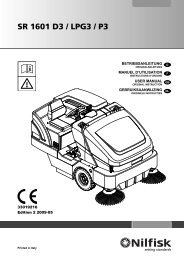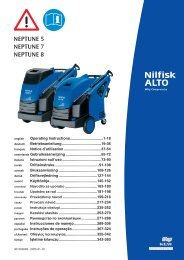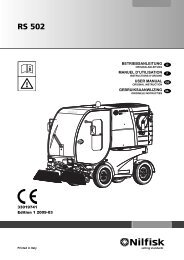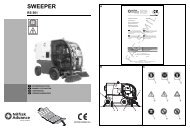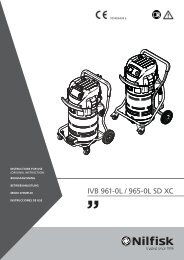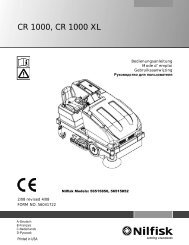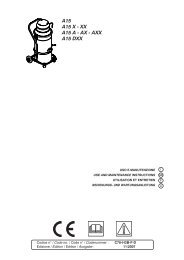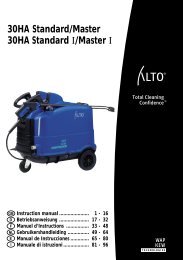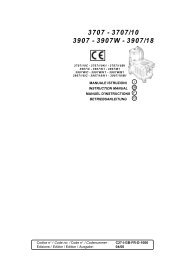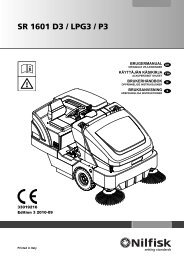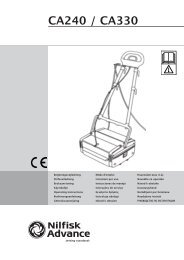FACA AAC AC-SIMILE LE - Nilfisk PARTS - Nilfisk-Advance
FACA AAC AC-SIMILE LE - Nilfisk PARTS - Nilfisk-Advance
FACA AAC AC-SIMILE LE - Nilfisk PARTS - Nilfisk-Advance
Sie wollen auch ein ePaper? Erhöhen Sie die Reichweite Ihrer Titel.
YUMPU macht aus Druck-PDFs automatisch weboptimierte ePaper, die Google liebt.
BRAKE FLUID <strong>LE</strong>VEL CHECK<br />
1. Engage the parking brake (7, Fig. E).<br />
2. Turn off the engine, by turning the ignition key (17, Fig.<br />
D) counterclockwise, to the end of stroke, then remove<br />
it.<br />
3. Open the right lid (16, Fig. G) by releasing the fasteners<br />
(17) with the supplied key.<br />
4. Check that the fluid level inside the tank (15, Fig. F) is<br />
between the minimum and maximum marks. If<br />
necessary top up using the same type of fluid that is in<br />
the line.<br />
Type of fluid used: DOT4.<br />
5. Close the right lid (16, Fig. G) by engaging the fasteners<br />
(17) with the supplied key.<br />
REVERSE GEAR BUZZER OPERATION<br />
CHECK<br />
1. Check that, when the machine moves in reverse, the<br />
relevant buzzer sounds.<br />
If necessary, adjust the relevant sensor according to the<br />
instructions in the Service Manual.<br />
TYRE PRESSURE CHECK<br />
1. Engage the parking brake (7, Fig. E).<br />
2. Turn off the engine, by turning the ignition key (17, Fig.<br />
D) counterclockwise, to the end of stroke, then remove<br />
it.<br />
3. The tyre pressure should be as follows:<br />
– Front tyres: 4.0 Bar<br />
– Rear tyres: 4.0 Bar<br />
WARNING!<br />
Please respect the recommended tyre<br />
pressure as stated in the relevant decals.<br />
The manufacturer rating is based on standard<br />
drive speed and standard load rating, different<br />
from the actual machine application.<br />
SUCTION IN<strong>LE</strong>T AND SKIRT HEIGHT AND<br />
OPERATION CHECK<br />
Preliminary operations<br />
1. Engage the parking brake (7, Fig. E).<br />
2. Lift the suction inlet (10, Fig. G) according to the<br />
procedure shown in the relevant paragraph.<br />
3. Turn off the engine, by turning the ignition key (17, Fig.<br />
D) counterclockwise, to the end of stroke, then remove<br />
it.<br />
Suction inlet wheel check<br />
4. Check that the three wheels (1, Fig. Z) of the suction inlet<br />
are in good conditions and turn freely (they must not be<br />
bent/misshapen because of bumps or excessive<br />
pressure, etc.). Check also that the rubber thickness (2)<br />
is not lower than some millimetre.<br />
If necessary replace the wheels (1) (see the procedure<br />
in the Service Manual).<br />
USER MANUAL<br />
Sliding panel check<br />
5. Check that the main sliding panel (3, Fig. Z) and the front<br />
sliding panels (4) and (5) are in good conditions and that<br />
their thickness (6) is not lower than 5 mm, otherwise<br />
replace them (see the procedure in the Service Manual).<br />
It is important to replace the sliding panels (3), (4), (5)<br />
when they are not completely worn, to avoid damaging<br />
the relevant mounting screws and making them difficult<br />
to remove.<br />
Replace the sliding panels (3), (4), (5) as a unit, to avoid<br />
steps in the union areas (7), caused by different levels of<br />
wear.<br />
Suction inlet skirt and wheel adjustment check<br />
6. Check that the skirt (8, Fig. Z) is integral and that it does<br />
not have excessive tears (10) or lacerations (11), which<br />
can affect the suction inlet operation.<br />
If necessary replace the skirt (8) (see the procedure in<br />
the Service Manual).<br />
7. Drive the machine on a level ground and lower the<br />
suction inlet (10, Fig. G) according to the procedure<br />
shown in the relevant paragraph.<br />
8. Turn off the engine, by turning the ignition key (17, Fig.<br />
D) counterclockwise, to the end of stroke, then remove<br />
it.<br />
9. Check that the distance (11, Fig. Z) of the skirt from the<br />
ground is not bigger than 1 cm. Greater distances can<br />
affect the suction inlet operation.<br />
If necessary replace the skirt (11) (see the procedure in<br />
the Service Manual).<br />
10. Also check that, when the wheels (1, Fig. Z) contact the<br />
ground, the sliding panels (3), (4), (5) do not touch the<br />
ground. Otherwise the wheels (1) must be replaced to<br />
avoid an excessive wear of the sliding panels (see the<br />
procedure in the Service Manual).<br />
11. Start the machine according to the procedure shown in<br />
the relevant paragraph, then lift the skirt (8, Fig. Z) and<br />
check that it lifts freely. Check that it lifts also when a<br />
force of some kg is applied (simulating to move bottles<br />
or other heavy objects that must then be collected). If<br />
necessary, adjust the opening force of the skirt (8)<br />
according to the following procedure:<br />
– Turn off the machine.<br />
– Remove the screws and the right panel (20, Fig. E)<br />
in the cab.<br />
– Loosen the control valve locknut (1, Fig. Y) and turn<br />
the screw (2) as necessary, reminding that:<br />
– The opening force decreases by loosening the<br />
screw;<br />
– The opening force increases by tightening the screw.<br />
– When the adjustment is completed, tighten the<br />
locknut (1).<br />
– Install the right panel (20, Fig. E) in the cab and<br />
tighten the screws.<br />
12. Assemble the components in the reverse order of<br />
disassembly.<br />
33014085(3)2006-06 A 23



